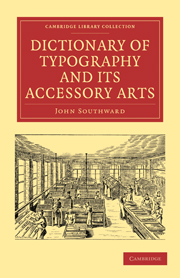Summary
QUADS.—An Abbreviation of quadrats.
QUADRATS.—Pieces of type metal of the depth of the body of the respective sizes to which they are cast, but lower than types, so as to leave a blank space on the paper when printed where they are placed. An en quadrat is half as thick as its depth; an em quadrat is equal in thickness and depth, and being square on its surface, is the true quadrat (from quadratus, squared); a two em quadrat is twice the thickness of its depth; a three em three times, a four em four times, as their names specify. Four ems are the largest quadrats that are cast. They are used to fill out short lines to form white lines, and to justify letters, figures, &c, in any part of the line or page. Four-em quadrats are rarely cast larger than Pica. English and Great Primer do not exceed three ems, nor does Double Pica exceed two ems. In casting em and en quadrats the utmost exactness is necessary; they also require particular care in dressing, as the most trifling variation will instantly be discovered when they are ranged in figure work; and unless true in their justification, the arrangement will be so irregular, that all the pains and ingenuity of a compositor cannot rectify it. The first line of a paragraph is usually indented an em quadrat, but some printers prefer using an em and en, two, or even three ems for wide measures. An em quadrat is the proper space after a full point when it terminates a sentence in a paragraph.
- Type
- Chapter
- Information
- Dictionary of Typography and its Accessory Arts , pp. 116 - 118Publisher: Cambridge University PressPrint publication year: 2010First published in: 1875



